11 Best Plants for Houston Landscaping
BY ABDUL WADOOD | MAY 2ND, 2023 | HOUSTON, LAWN CARE, TEXASHouston is hot, dry, and sunny, but that doesn’t mean you can’t have a beautiful yard. Texas native plants can adapt to Houston’s climate and soil conditions as they have been growing here for years.
Let’s take a look at the best native plants for Houston that can add charm to your yard.
In this article:
- Why Native Plants?
- Best Native Plants for Your Houston Lawn
- What Is the Best Native Plant for Houston Lawns?
Why Native Plants?
Native plants are well-adapted to a region’s soil conditions and climate, giving them a distinct advantage over non-native plants.
Here are the advantages of native plants over non-natives.
- They are already adapted to Houston’s climate and your yard’s soil conditions.
- Butterflies, bees, hummingbirds, moths, and other pollinators are attracted to them.
- They don’t require frequent watering and fertilization.
- They resist pests and diseases.
Best Native Plants for Your Houston Lawn
1. Black-Eyed Susan (Rudbeckia Hirta)
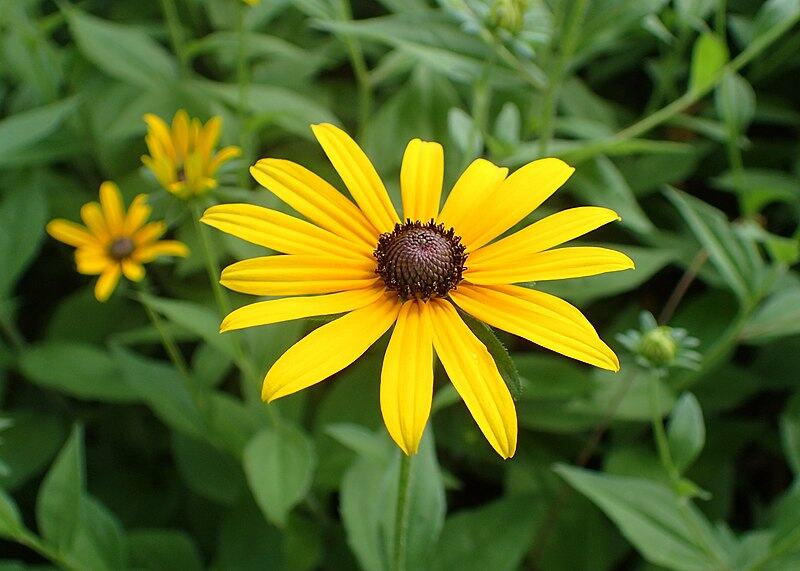
Photo Credit: Krzysztof Ziarnek, Kenraiz / Wikimedia Commons / CC BY-SA 4.0
Black-eyed Susan looks distinctive, with bright yellow petals and a brownish-black head in the center. It grows best in full sun and prefers moist soil with good drainage.
Black-eyed Susan is a low-maintenance plant that blooms from summer to fall, attracting butterflies, birds, and bees. You can remove the faded and dried flowers to keep black-eyed Susan in bloom longer.
Growth habit: Herb
Mature size: Up to 5 feet tall and 3 feet wide
Duration: Perennial
Foliage: Deep green
Sunlight needs: Full sun
Soil preferences: Moist, well-drained
Water needs: Low
Potential hazards: Non-toxic
2. Eastern Purple Coneflower (Echinacea Purpurea)
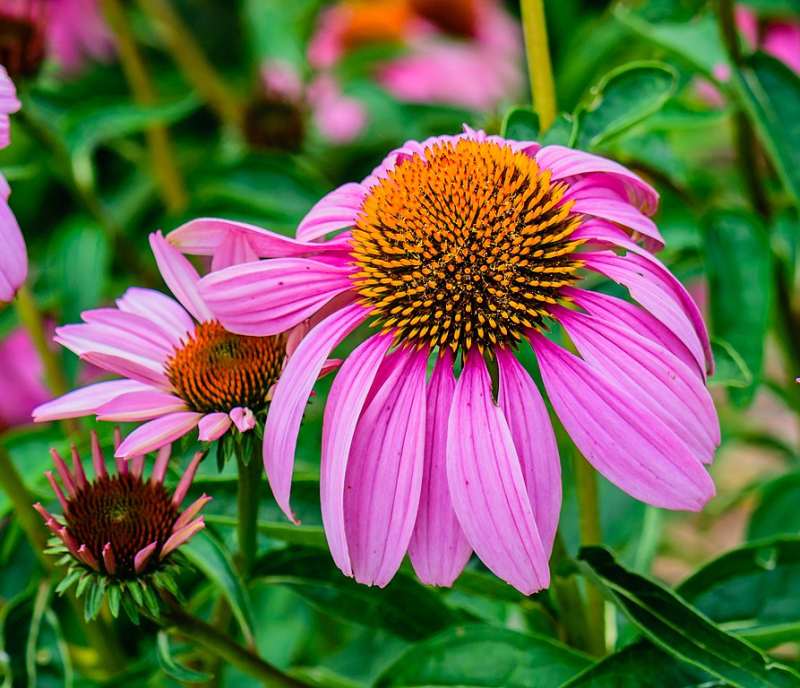
Photo Credit: PumpkinSky / Wikimedia Commons / CC BY-SA 4.0
Eastern purple coneflower is popular in Texas for its appealing pinkish-purple flowers and a dome-shaped brownish-orange head. Eastern purple coneflower blooms from spring to summer. Butterflies and bees love them.
Eastern purple coneflower grows best in full sun but can tolerate partial shade. It prefers moist loam soil with good drainage. However, it can quickly adapt to various soil types.
Growth habit: Herb
Mature size: Up to 5 feet tall and 2 feet wide
Duration: Perennial
Foliage: Deep green
Sunlight needs: Full sun to partial shade
Soil preferences: Clay, loamy, sandy, well-drained soil
Water needs: Moderate
Potential hazards: Non-toxic
3. Giant Coneflower (Rudbeckia Maxima)
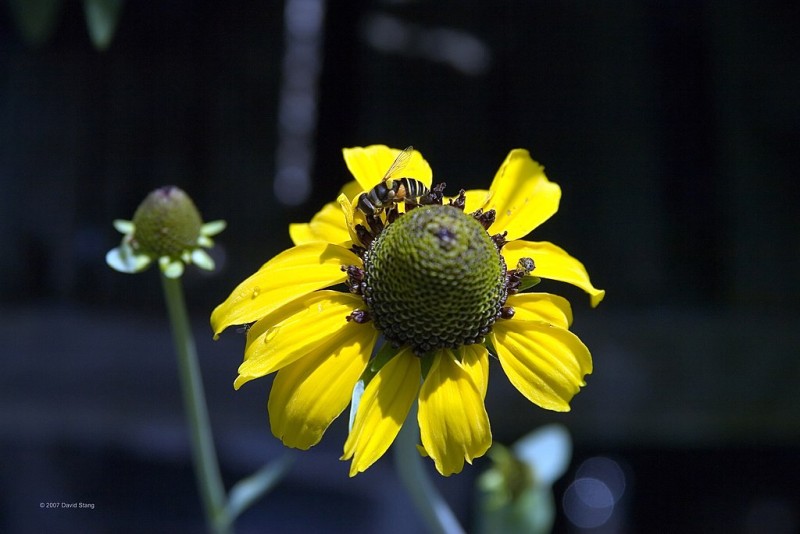
Photo Credit: Photo by David J. Stang / Wikimedia Commons / CC BY-SA 4.0
Giant coneflower is an attractive tall herbaceous perennial with bright yellow flowers and a large, dark brown center. It’s a super-sized black-eyed Susan. Giant coneflower grows best in full sun and prefers moist soil with good drainage. It tolerates partial shade and drought.
Giant coneflower blooms from mid-summer to early fall. It attracts bees, butterflies, and other pollinators.
Growth habit: Herb
Mature size: Up to 7 feet tall and 4 feet wide
Duration: Perennial
Foliage: Green
Sunlight needs: Full sun to partial shade
Soil preferences: Moist, well-drained soil
Water needs: High
Potential hazards: Non-toxic
4. Texas Lantana (Lantana Urticoides)
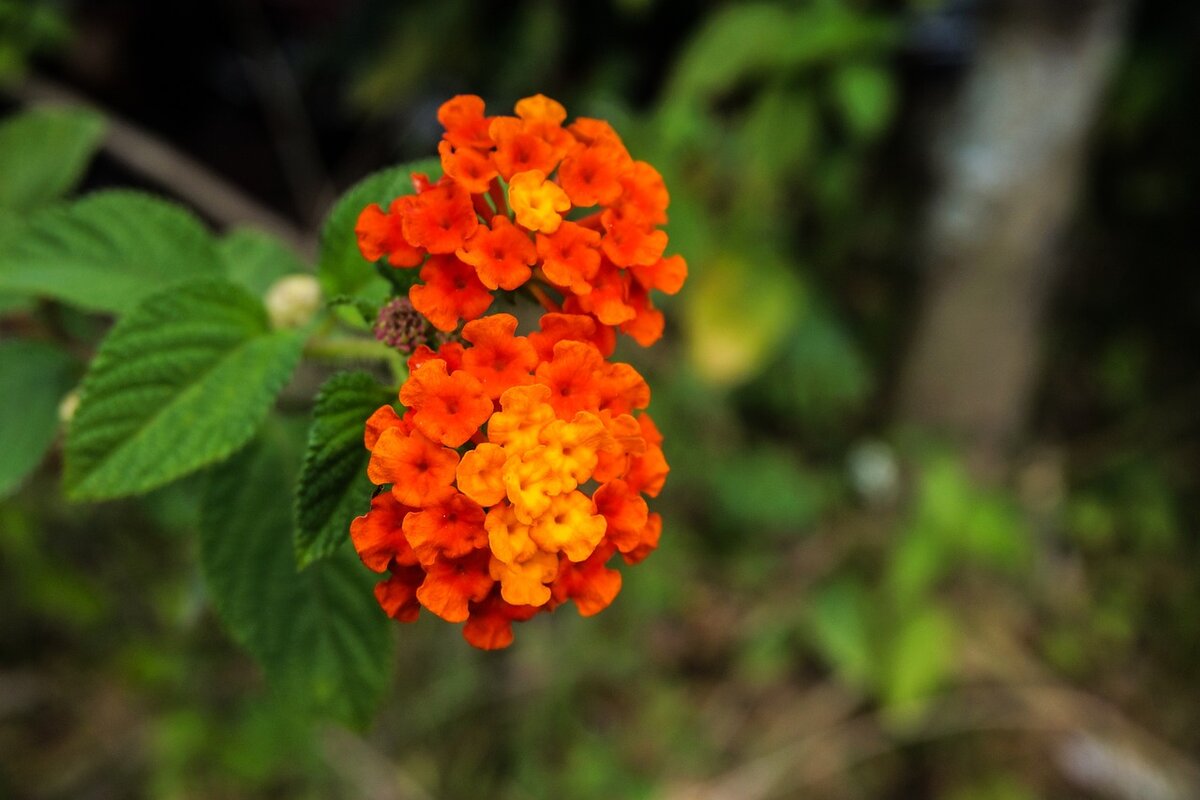
Photo Credit: Pixabay
Texas lantana blooms throughout the summer, producing tiny bright flowers arranged in thick clusters. The flowers may appear orange, red, white, purple, or pink. These flowers create a bicolored effect as they are mixed within the same cluster.
Texas lantana grows best in full sun and prefers soil with good drainage. If you have children and pets playing on your lawn, we recommend avoiding this shrub as it’s toxic. Texas lantana leaves have a wrinkled appearance with a pungent citrusy smell. The strong aroma prevents deer from entering your yard.
Growth habit: Shrub
Mature size: Up to 3 feet tall and 6 feet wide
Duration: Perennial
Foliage: Deep green
Sunlight needs: Full sun to partial shade
Soil preferences: Clay, loamy, sandy, well-drained soil. Grows in almost all soil types.
Water needs: Low
Potential hazards: Toxic to children and pets
5. American Beautyberry (Callicarpa Americana)
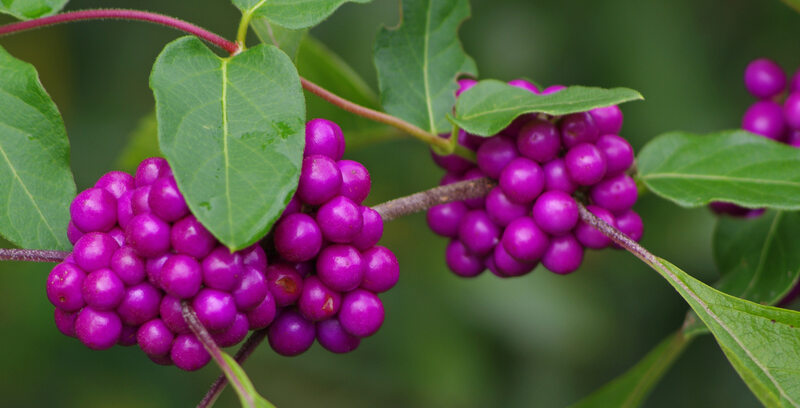
Photo Credit: Virginia State Parks staff / Wikimedia Commons / CC BY 2.0
American beautyberry blooms from late spring to early summer, producing clusters of tiny pink flowers. These flowers mature into berries during fall. Birds love them. We can eat them, too, but they don’t taste good.
American beautyberry grows best in full sun and can tolerate shade. It prefers moist, well-drained soil. It can grow up to 6 feet, but keep it trimmed for a better appearance.
Growth habit: Shrub
Mature size: Up to 6 feet tall and wide
Duration: Perennial
Foliage: Light green
Sunlight needs: Full sun to partial shade
Soil preferences: Clay, loamy, sandy, moist, well-drained soil
Water needs: Moderate
Potential hazards: Non-toxic
6. Autumn Sage (Salvia Greggii)
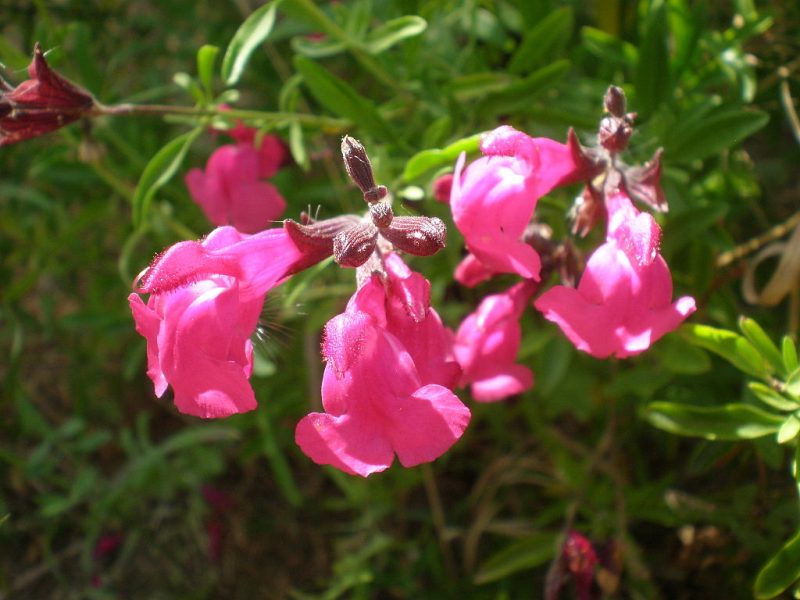
Photo Credit: Consultaplantas / Wikimedia Commons / CC BY-SA 4.0
Autumn sage is a fast-growing shrub that blooms for a lengthy period, from late spring to mid-fall. The beautiful red flowers attract hummingbirds, butterflies, and bees. Autumn sage grows best in full sun and prefers dry, well-drained soil.
Autumn sage requires regular watering after planting. Once grown, it can survive with an inch of watering each week. Avoid overwatering as it can damage the shrub. Autumn sage leaves are small and have a minty aroma.
Growth habit: Shrub
Mature size: Up to 3 feet tall and wide
Duration: Perennial
Foliage: Green
Sunlight needs: Full sun
Soil preferences: Well-drained
Water needs: Low
Potential hazards: Non-toxic
7. Passionflower (Passiflora Incarnata)

Photo Credit: H. Zell / Wikimedia Commons / CC BY-SA 3.0
Passionflower looks beautiful with purple or white flowers. It features complex purple threadlike coronal filaments that stand out. Passionflower grows tall, reaching up to 30 feet. It grows best in full sun and prefers rich, moist soil with good drainage.
Passionflower blooms in summer and attracts hummingbirds, bees, and butterflies. It’s toxic to pets but doesn’t affect humans much.
Growth habit: Vine
Mature size: Up to 30 feet tall and 6 feet wide
Duration: Perennial
Foliage: Green
Sunlight needs: Full sun to partial shade
Soil preferences: Clay, loamy, sandy, well-drained soil
Water needs: Moderate
Potential hazards: Toxic to humans and pets
8. Coral Honeysuckle (Lonicera Sempervirens)
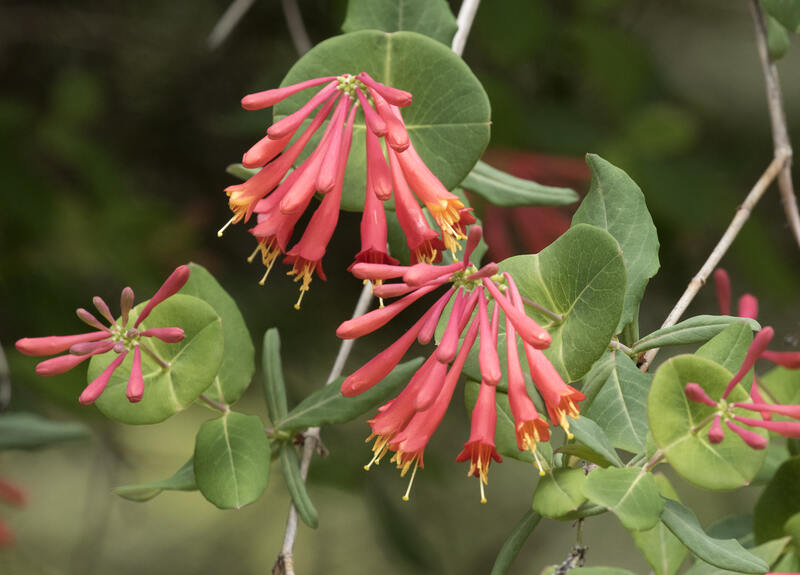
Photo Credit: Zeynel Cebeci / Wikimedia Commons / CC BY-SA 4.0
Coral honeysuckle is a showy vine that can add charm to your lawn. It features clusters of pinkish-red tubular flowers. Bees, butterflies, and hummingbirds love these flowers. Coral honeysuckle usually blooms throughout the summer. During fall, these flowers mature into berries that songbirds love.
Coral honeysuckle grows best in full sun. It can tolerate partial shade but will flower slowly. It grows in any soil type with good drainage.
Growth habit: Vine
Mature size: Up to 25 feet tall and wide
Duration: Perennial
Foliage: Deep green
Sunlight needs: Full sun to partial shade
Soil preferences: Clay, loamy, sandy, well-drained soil
Water needs: Moderate
Potential hazards: Toxic to humans and pets
9. Carolina Jessamine (Gelsemium Sempervirens)
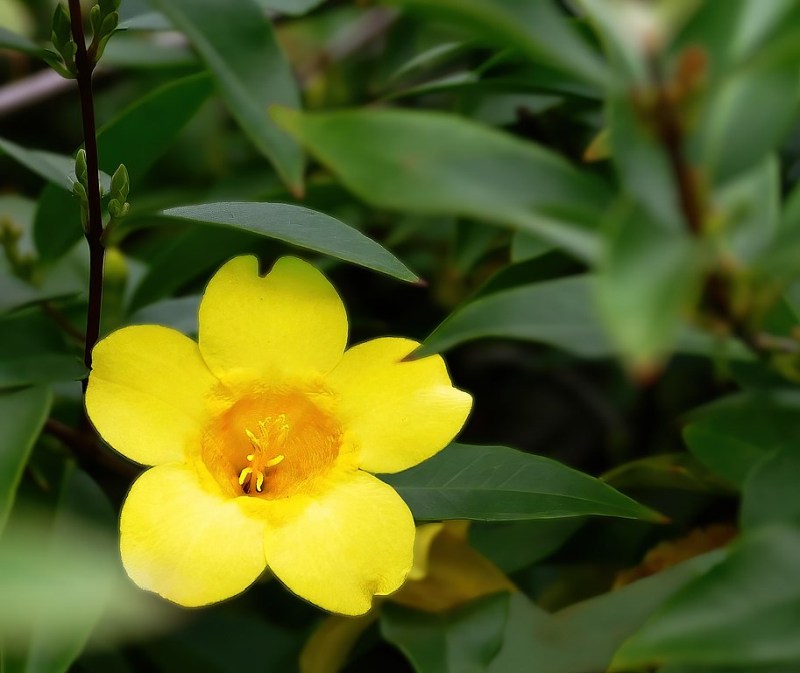
Photo Credit: Jim Evans / Wikimedia Commons / CC BY-SA 4.0
Carolina jessamine looks beautiful with its trumpet-shaped bright yellow flowers. It blooms from late winter to early spring, making it one of the earliest bloomers. Carolina jessamine prefers moist, well-drained soil.
You can plant Carolina jessamine near your fence or arbor as it acts like a privacy screen. It also does well as a ground cover. Carolina jessamine grows best in full sun and can tolerate partial shade.
Carolina jessamine is extremely toxic and can even cause death to humans and pets when consumed. So, if you have kids and pets, we strongly recommend you avoid this vine.
Growth habit: Vine
Mature size: Up to 10 feet tall and 3 feet wide
Duration: Perennial
Foliage: Deep green
Sunlight needs: Full sun to partial shade
Soil preferences: Clay, loamy, sandy, moist, well-drained soil
Water needs: Moderate
Potential hazards: Toxic to humans and pets
10. White Oak (Quercus Alba)
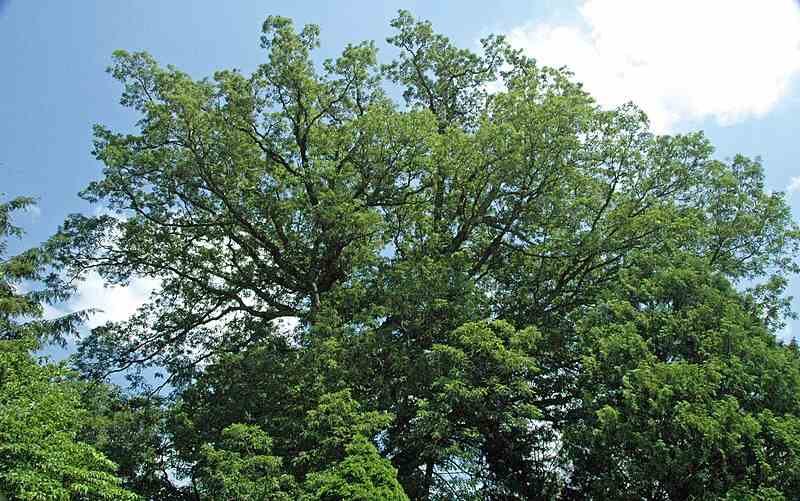
Photo Credit: James St. John / Wikimedia Commons / CC BY 2.0
White oak has many benefits. Its bark is used to make medicines, furniture, and even boats. It grows extremely slowly at a rate of 2 feet per year but can comfortably last 500 to 600 years. White oak grows best in full sun and prefers deep, moist, well-drained soil.
White oak can grow up to 100 feet in height, and the canopy can spread to 80 feet. So, if you want to plant this tree, ensure there’s sufficient space in your lawn. White oak is susceptible to many diseases and pests.
Deers love the acorns that white oak produces. But don’t worry yet. Most white oak trees don’t produce acorns until they reach 20 years of age.
Growth habit: Tree
Mature size: Up to 100 feet tall and 80 feet wide
Duration: Perennial
Foliage: Dark green in summer and brown to orange-red in fall
Sunlight needs: Full sun to partial shade
Soil preferences: Clay, loamy, sandy, moist, well-drained soil
Water needs: Moderate
Potential hazards: Toxic to humans and pets
11. Shumard Red Oak (Quercus Shumardii)
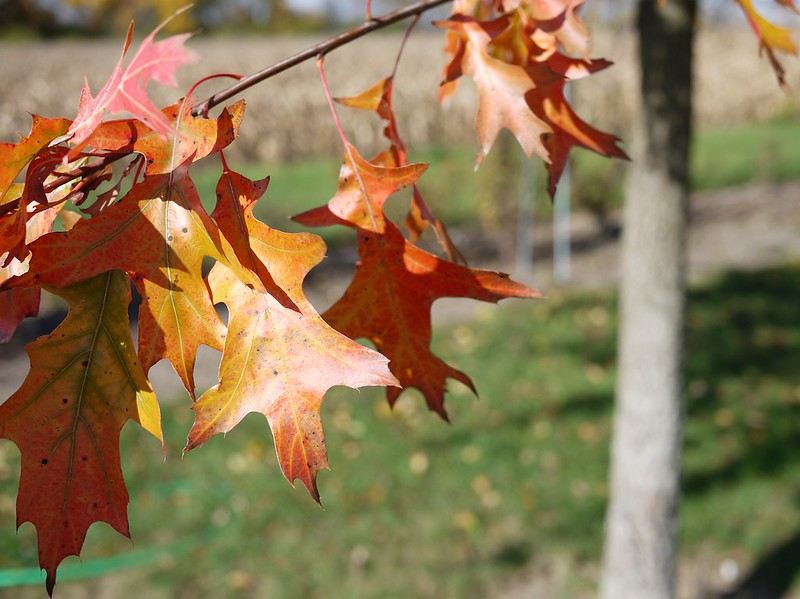
Photo Credit: F. D. Richards / Flickr / CC BY-SA 2.0
If you want a fast-growing oak tree, go for Shumard red oak. It grows about 3 feet per year. The growth rate isn’t too fast, but definitely better than white oak. On the downside, Shumard red oak lasts up to 480 years, significantly lesser than white oak.
Shumard red oak grows best in full sun and prefers moist loam soil with good drainage. It can grow up to 120 feet. Shumard red oak turns reddish-orange during fall. Similar to white oak, this tree’s bark also has many benefits.
Growth habit: Tree
Mature size: Up to 120 feet tall and 90 wide
Duration: Perennial
Foliage: Deep green
Sunlight needs: Full sun to partial shade
Soil preferences: Loamy, moist, well-drained soil
Water needs: Moderate
Potential hazards: Toxic to humans and pets
The Final Word
Houston’s hardiness zone is 9a, meaning the weather is hot, dry, and sunny for most of the year. All these plants are native to Texas and can survive Houston’s climate. We recommend you analyze your lawn’s condition and choose a plant that best suits your lifestyle.
Also, don’t forget to consider a plant’s size when purchasing it. If there isn’t much space in your lawn, it’s best to avoid planting large trees.
If you want to know more about these plants and want to make your lawn the envy of your neighbors, get in touch with Wikilawn’s Houston lawn care experts.
Main Photo Credit: Brian Reading / Wikimedia Commons / CC BY-SA 3.0